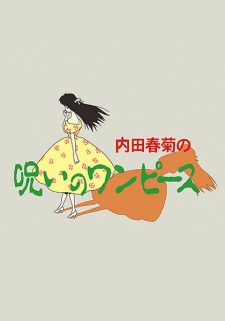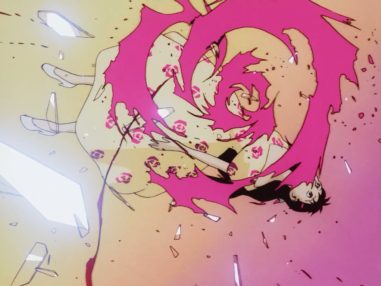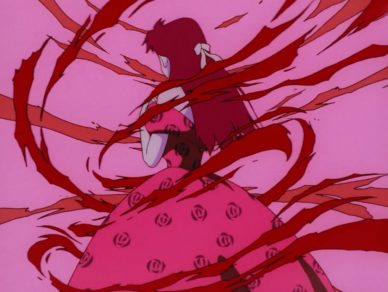 A cursed dress? That’s been the premise of several films in the past thirty years, including Alex van Warmerdam’s seriocomic THE DRESS/DE JURK (1996), about a dress that affects the lives of everyone who comes into contact with it in various odd and comedic ways, and Peter Strickland’s more horrific IN FABRIC (2018), about, once again, a dress that dramatically affects the fortunes of its wearers. Arriving on the scene before both (and possibly influencing them) was Yoshiji Kigami‘s THE CURSED ONE-PIECE/NO NOROI NO ONE-PIECE, a 3-part, 25-minute anime TV special from 1992. Inspired by a manga by Uchida Shungiku, the program may not be particularly great, but it is the most satisfying of the three pics (as you’ve probably figured out, I’m not too enamored with the Warmerdam and Strickland films).
A cursed dress? That’s been the premise of several films in the past thirty years, including Alex van Warmerdam’s seriocomic THE DRESS/DE JURK (1996), about a dress that affects the lives of everyone who comes into contact with it in various odd and comedic ways, and Peter Strickland’s more horrific IN FABRIC (2018), about, once again, a dress that dramatically affects the fortunes of its wearers. Arriving on the scene before both (and possibly influencing them) was Yoshiji Kigami‘s THE CURSED ONE-PIECE/NO NOROI NO ONE-PIECE, a 3-part, 25-minute anime TV special from 1992. Inspired by a manga by Uchida Shungiku, the program may not be particularly great, but it is the most satisfying of the three pics (as you’ve probably figured out, I’m not too enamored with the Warmerdam and Strickland films).
A cursed dress? That’s been the premise of several films in the past thirty years…
Another film THE CURSED ONE-PIECE recalls is Satoshi Kon’s PERFECT BLUE/PÂFEKUTO BURÛ, a breakthrough anime feature from 1997. A keenly wrought, subtly unnerving psychological thriller about a pop singer-turned-actress losing her grip on reality due to the attentions of a stalker, it was a low budget affair made for Japan’s OVA (Original video animation) market that, to the surprise of everyone involved, ended up being sold as a feature film that was orgasmically received at festivals the world over.
THE CURSED ONE-PIECE, obviously, did not receive an equivalent reception. It remains little-known even in its native Japan, and quality-wise will never be ranked with PERFECT BLUE. Yet it poses a challenge to adherents of the latter film, and the frequent claim that there was “no precedent” for its brand of psychological horror. Psychological horror is precisely what THE CURSED ONE-PIECE offers in its triple-tiered narrative, along with more traditional supernatural shenanigans in the form of that accursed dress.
PART ONE
Psychological horror is precisely what THE CURSED ONE-PIECE offers in its triple-tiered narrative…
The first portion, lasting a little over seven minutes (the standard runtime for all three), is “Yuuko,” which establishes the discordant psychoscapes and audacious color schemes that pervade all three segments. The title character is a teenage girl whose overriding wish is stated in the opening dream sequence: “I want to be pretty.” She’s in love with a stud named Doi-Kun, and figures that upgrading her appearance will get him to notice her. When a box containing a yellow one-piece dress with red flower designs turns up on her doorstep, it would seem to be the answer to her prayers, despite her mother’s claim that “I can’t really explain it, but that one-piece makes me really uncomfortable.” Yuuko wears it to a party anyway, with horrific results.
“Kaori” is a second love-struck young woman who comes into contact with the accursed one-piece. The object of her desire is another attractive young man, this one named Takayuki, and the dress is bequeathed by her parents. As in the first segment, Kaori gradually loses her hold on reality and, as she finds herself constantly waking up in bed wearing the garment, becomes convinced the dress is to blame.
PART TWO
“Michiyo” is yet another romantically inclined gal. She pines for her classmate Togashi, who to her great disappointment has elected to switch schools. The one-piece turns up on her doorstep one day, accompanied by a note alleging to be from Togashi in which he professes his love for her and says he wants to spend the day with her. Michiyo wastes no time donning the dress and rushing off to meet her crush, while back home her little sister discovers that Togashi died in a car crash the previous day, and that a young woman has been seen running around the neighborhood holding hands with a spectral being…
PART THREE
 Story-wise the series peaks early, with part one being the most compelling and unnerving of the three. Its emphasis on psychological unrest, conveyed via bright splashes of red and blue, puts it in giallo territory far removed from traditional anime television, while the fractured and discordant editing recalls Nicolas Roeg. Certainly nothing else by director Yoshiji Kigami (which includes more traditional anime fare like the 2003-05 OVA series MUNTO) can prepare viewers for THE CURSED ONE-PIECE, and nor can other anime TV specials (the closest equivalent I can find is FUJIKO FUJIO A NO MUMAKO, a manga-inspired three-parter from 1990 that likewise pivots on dreams and reality, albeit in more predictable wish-fulfillment scenarios).
Story-wise the series peaks early, with part one being the most compelling and unnerving of the three. Its emphasis on psychological unrest, conveyed via bright splashes of red and blue, puts it in giallo territory far removed from traditional anime television, while the fractured and discordant editing recalls Nicolas Roeg. Certainly nothing else by director Yoshiji Kigami (which includes more traditional anime fare like the 2003-05 OVA series MUNTO) can prepare viewers for THE CURSED ONE-PIECE, and nor can other anime TV specials (the closest equivalent I can find is FUJIKO FUJIO A NO MUMAKO, a manga-inspired three-parter from 1990 that likewise pivots on dreams and reality, albeit in more predictable wish-fulfillment scenarios).
 Another aspect of THE CURSED ONE-PIECE’s uniqueness is its look. It was the first in-house production by the then-upstart Kyoto Animation, which partnered with the more seasoned Shin-Ei Animation, resulting in visuals that combine the hidebound old with the more fluid and lifelike—read: Disney inspired—new styled anime. The project’s low budget orientation is painfully evident in the jerkiness of the character movements and overuse of still pictures, but the animation is a definite step up from what was considered standard at the time (contrast THE CURSED ONE-PIECE with the aforementioned FUJIKO FUJIO A NO MUMAKO, a Shin-Ei production that’s very much a product of the old school).
Another aspect of THE CURSED ONE-PIECE’s uniqueness is its look. It was the first in-house production by the then-upstart Kyoto Animation, which partnered with the more seasoned Shin-Ei Animation, resulting in visuals that combine the hidebound old with the more fluid and lifelike—read: Disney inspired—new styled anime. The project’s low budget orientation is painfully evident in the jerkiness of the character movements and overuse of still pictures, but the animation is a definite step up from what was considered standard at the time (contrast THE CURSED ONE-PIECE with the aforementioned FUJIKO FUJIO A NO MUMAKO, a Shin-Ei production that’s very much a product of the old school).
THE CURSED ONE-PIECE appears to be largely forgotten today. That may be for the best, as, again, it’s far from great, but I think it can take its place as, if nothing else, the finest haunted dress narrative ever filmed.
